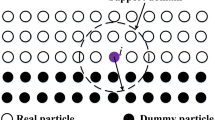Abstract
This paper deals with the numerical solution and validation of a reactive flow model dedicated to the study of spherical explosions with an aluminized energetic material. Situations related to air blast as well as underwater explosions are examined. Such situations involve multiscale phenomena associated with the detonation reaction zone, the aluminium reaction zone, the shock propagation distance and the bubble oscillation period. A detonation tracking method is developed in order to avoid the detonation structure computation. An ALE formulation is combined to the detonation tracking method in order to solve the material interface between detonation products and the environment as well as shock propagation. The model and the algorithm are then validated over a wide range of spherical explosions involving several types of explosives, both in air and liquid water environment. Large-scale experiments have been done in order to determine the blast wave effects with explosive compositions of variable aluminium content. In all situations the agreement between computed and experimental results is very good.
Similar content being viewed by others
References
Baer M.R., Nunziato J.W. (1986) A two-phase mixture theory for the deflagration-to-detonation transition (DDT) in reactive granular materials. Int. J. Multiphase Flows 12, 861–889
Baudin, G., Bergues, D.: A reaction model for aluminized PBX applied to underwater explosion calculations. In: The 10th Symposium on Detonation, Boston, USA (1993)
Baudin, G.: QUERCY, Un code thermochimique adapté au calcul des caractéristiques de détonation des explosifs aluminisés. In: Europyro 93, 5 th International Congres on Pyrotechnics, 6–11 June 1993, Tours, France (1993)
Bergues, D., Baudin, G.: Prédiction des performances sous-marines dexplosifs aluminisés partir dinformations recueillies lors de tests balistiques aériens (coopération Franco-Britannique WG7-SG2). Note technique T94-24, DGA/DRET/CEG (in French)(1994)
Bdzil J.B., Stewart P.S. (1989) Modeling two-dimensional detonations with detonation shock dynamics. Phys. Fluids A1(7): 1261–1267
Brun, L.: Un nouveau modèle macroscopique de la détonation non soutenue dans les explosifs condensés. In: 3eme Symp. Int. Hautes Pressions Dynamiques, La Grande Motte, pp. 103–107 (1989)
Chinnayya A., Daniel E., Saurel R. (2004) Modelling detonation waves in heterogeneous energetic materials. J. Comput. Phys. 196(2): 490–538
Cole R.H. (1965) Underwater Explosions. Dover, New York
Davis S.F. (1988) Simplified second order Godunov type methods. SIAM J. Sci. Stat. Comput. 9 (N3): 445–473
Fickett W., Davis W.C. (1979) Detonation. University of California Press, Berkeley
Fried, E.: CHEETAH 1.39 user’s manual. UCRL-MA-117541 Rev 3, Energetic Material Center. Lawrence Livermore National Laboratory (1996)
Godunov S.K. (1959) A finite difference method for the numerical computation of discontinuous solutions of the equations of fluid dynamics. Math. Sb. 47: 375
Godunov S.K. (1979) Résolution numérique des problèmes multidimensionnels de la dynamique des gaz. Editions Mir, Moscou, USSR
Harlow, F.H., Amsden, A.A.: Fluid dynamics. Los Alamos Scientific Laboratory, LA-4700, UC 34 (1971)
Heuzé O. (1986) Equation of state of detonation products: influence in the repulsive intermolecular potential. Phys. Rev. A 34(1): 428–433
Lee, E.L., Horning, H.C., Kury, J.W.: Adiabatic expansion of high Explosives detonation products. Lawrence Radiation Lab., Un. of Cal., Livermore, TID 4500 – UCRL 50422 (1968)
Kingery, C.N., Pannill, B.F.: Peak overspressure vs scaled distance for TNT surface bursts (hemispherical charges). Ballistic Research Laboratories n518, Maryland (1964)
Kingery, C.N.: Air blast parameters vs distance for hemispherical TNT surface bursts. Ballistic Research Laboratories n 1544, Maryland (1966)
Kingery, C.N., Bulmash, G.: Air blast parameters from TNT air burst and hemispherical surface burst. Technical ARBRL-TR-02555, U.S. Army ARDC-BRL, Aberdeen Proving Ground, Maryland (1984)
Menikoff R., Plohr B. (1989) The Riemann problem for fluid flow of real materials. Rev. Mod. Phys. 61, 75–130
Persson P.A., Holmberg R., Lee J. (1996) Rock blasting and explosive engineering. CRC Press, Boca Raton
Rayleigh L. (1917) On the pressure developed in a liquid during the collapse of a spherical cavity. Phys. Mag. 34, 94–98
Saurel, R.: DPEX: Un outil numérique pour la détermination des cinétiques réactionnelles des explosifs fortement non idéaux. IUSTI Report under Centre d’Etude de Gramat contract (1996)
Saurel R., Massoni J. (1998) On Riemann-problem-based methods for detonations in solid energetic materials. Int. J. Num. Meth. Fluids 26, 101–121
Saurel R., Le Metayer O. (2001) A multiphase model for compressible flows with interfaces, shocks, detonation waves and cavitation. J. Fluid Mech. 431, 239–271
Toro E.F., Spruce M., Spearce W. (1994) Restauration of the contact surface in the HLL-type Riemann solver. Shock Waves 4, 25–34
Wood W.W., Kirkwood J.C. (1954) Diameter effect in condensed explosives.The relationship between velocity and radius of curvature of the detonation wave. J. Chem. Phys. 22, 1920–1924
Zhang F., Frost D.L., Thibault P.A., Murray S.B. (2001) Explosive dispersal of solid particles. Shock Waves 10, 431–443
Author information
Authors and Affiliations
Corresponding author
Additional information
Communicated by E. Timofeev.
Rights and permissions
About this article
Cite this article
Massoni, J., Saurel, R., Lefrançois, A. et al. Modeling spherical explosions with aluminized energetic materials. Shock Waves 16, 75–92 (2006). https://doi.org/10.1007/s00193-006-0053-y
Received:
Accepted:
Published:
Issue Date:
DOI: https://doi.org/10.1007/s00193-006-0053-y



